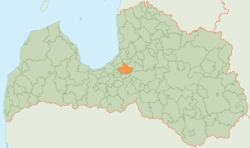Ropaži Municipality
Ropaži Municipality (Latvian: Ropažu novads) is a municipality in Vidzeme, Latvia. The municipality was formed in 2005 by reorganization of Ropaži parish the administrative centre being Ropaži.
Ropaži Municipality Ropažu novads | |
|---|---|
 Flag  Coat of arms | |
 | |
| Country | |
| Formed | 2005 |
| Centre | Ropaži |
| Government | |
| • Mayor | Zigurds Blaus |
| Area | |
| • Total | 322 km2 (124 sq mi) |
| Population (2009)[2] | |
| • Total | 6,832 |
| • Density | 21/km2 (55/sq mi) |
| Website | ropazi |
The center of Ropaži is 36 km from Riga, the capital of Latvia. Through the territory of Ropaži municipality pass the Riga – Ērgļi railway, the European route E67 also known as Via Baltica, and the highways Riga – Lubāna and Ogre – Inčukalns.
Territory: 322 km².
Population: 6.832 inhabitants.
As of 1 January 2002 the largest villages are:
History
The territory of Ropaži district has been inhabited since the Stone Age – Neolithic era, (3,000 years B.C.) 4 ancient cemeteries and stone objects found there give proof of that.
The first written evidences of Ropaži and its inhabitants go back to 1205, when Henry of Livonia mentioned Ropaži in the Indrikis chronicles. A. Beilenstein considered the inhabitants of the district to be Liivs of the Daugava. In about 1320 the Livonian Order built a stone castle at Ropaži which served as a centre of district administration. The castle was destroyed in the Livonian War, in the 17th century. In 1320 the Lutheran Parish was mentioned.
In the 16th century one of the most important routes of Vidzeme led through Ropaži.
In the 18th century the baronial Bergi family obtained Ropaži manor and carried out large construction works. The gardener Daniel Ebel formed one of the first garden parks of Latvia. In an area of 93,000 square metres 29 species of trees and bushes were planted.
In reports of 1736 we can find information about the education of children. In 1766 the parish school “Parupes” was established. Two famous Latvians worked there: the writer and translator Augusts Kažoks, an adherent of "The New Current", and the poet Doku Atis.
On 18 August 1804 the clergyman C. von Walter described Professor Robertson’s flight from Riga to Ropaži in a hot-air balloon.
In 1855 Ropaži manor became the property of Baron Victor von Wolf. At the beginning of the 19th century the Ropaži manor was burned down.
Ropaži was seriously affected by World War I and World War II. In year 1949 over 150 inhabitants suffered repressions.
In 1936 Ropaži 7–grade Primary School was built; in 1960 it was changed to a secondary school.
In Ropaži are many significant cultural and natural features:
- Kangari Hills – 65 m above sea level, and a restricted nature area of 6.72 km²
- Lielkangari Marsh - 8.32 km²
- Ancient cemetery – Stone Age
See also
- Administrative divisions of Latvia (2009)